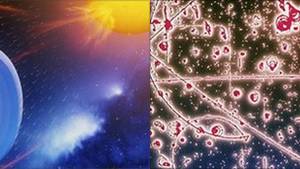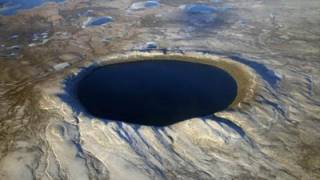Antimatter belt around Earth discovered by Pamela craft
Source: bbc.co.uk

The antiprotons lie sandwiched between the inner and outer Van Allen belts (in red) around the Earth
A thin band of antimatter particles called antiprotons enveloping the Earth has been spotted for the first time.
The find, described in Astrophysical Journal Letters, confirms theoretical work that predicted the Earth’s magnetic field could trap antimatter.
The team says a small number of antiprotons lie between the Van Allen belts of trapped "normal" matter.
The researchers say there may be enough to implement a scheme using antimatter to fuel future spacecraft.
The antiprotons were spotted by the Pamela satellite (an acronym for Payload for Antimatter Matter Exploration and Light-nuclei Astrophysics) - launched in 2006 to study the nature of high-energy particles from the Sun and from beyond our Solar System - so-called cosmic rays.
These cosmic ray particles can slam into molecules that make up the Earth’s atmosphere, creating showers of particles.
Many of the cosmic ray particles or these "daughter" particles they create are caught in the Van Allen belts, doughnut-shaped regions where the Earth’s magnetic field traps them.
Among Pamela’s goals was to specifically look for small numbers of antimatter particles among the far more abundant normal matter particles such as protons and the nuclei of helium atoms.
’Abundant source’
The new analysis, described in an online preprint, shows that when Pamela passes through a region called the South Atlantic Anomaly, it sees thousands of times more antiprotons than are expected to come from normal particle decays, or from elsewhere in the cosmos.
The team says that this is evidence that bands of antiprotons, analogous to the Van Allen belts, hold the antiprotons in place - at least until they encounter the normal matter of the atmosphere, when they "annihilate" in a flash of light.
The band is "the most abundant source of antiprotons near the Earth", said Alessandro Bruno of the University of Bari, a co-author of the work.
"Trapped antiprotons can be lost in the interactions with atmospheric constituents, especially at low altitudes where the annihilation becomes the main loss mechanism," he told BBC News.
"Above altitudes of several hundred kilometres, the loss rate is significantly lower, allowing a large supply of antiprotons to be produced."
Dr Bruno said that, aside from confirming theoretical work that had long predicted the existence of these antimatter bands, the particles could also prove to be a novel fuel source for future spacecraft - an idea explored in a report for Nasa’s Institute for Advanced Concepts.






















